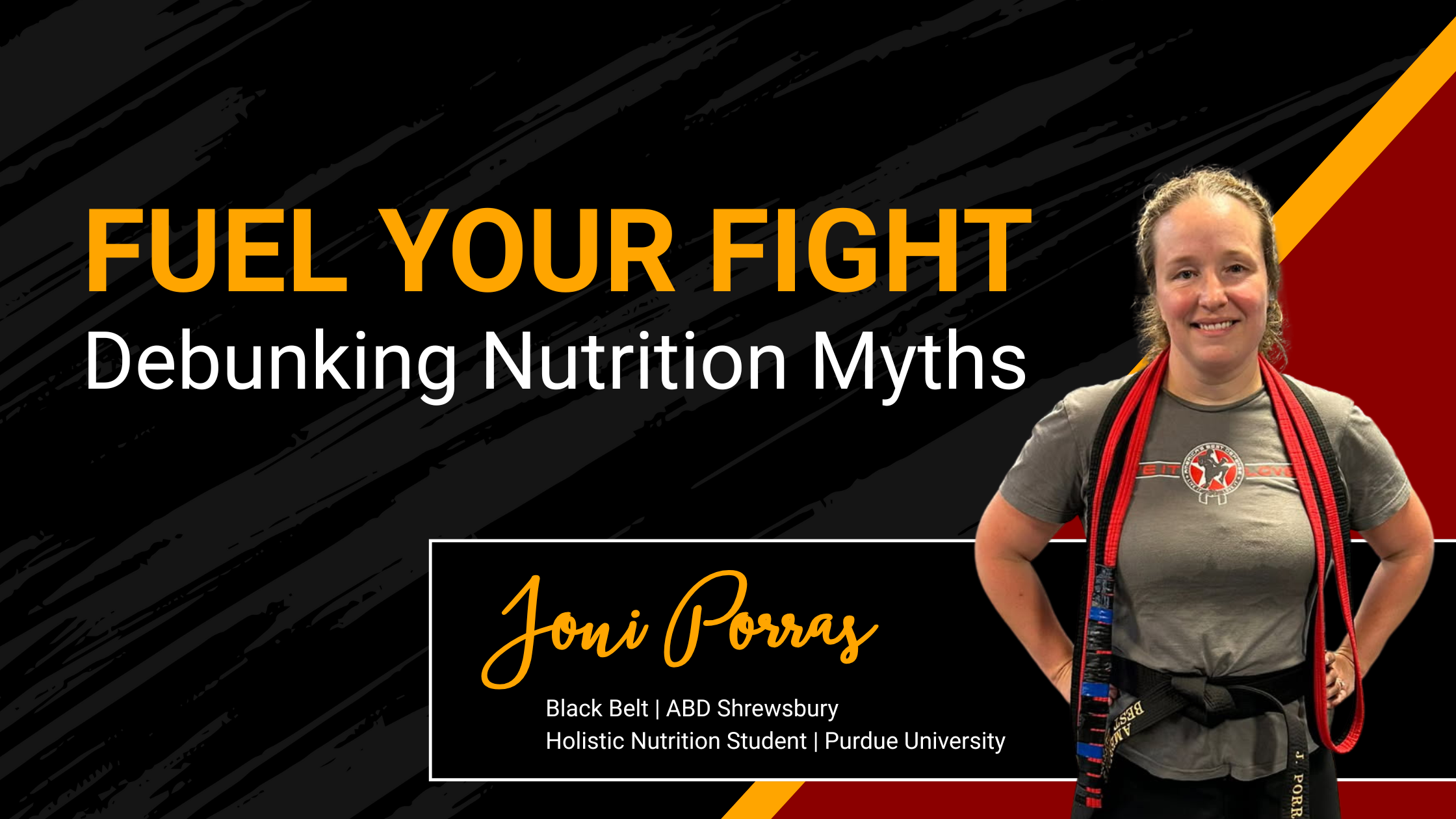When it comes to improving martial arts performance, most people focus on training frequency, sparring rounds, and belt goals. But what you eat matters just as much—if not more.
Even the most dedicated martial artists have been known to enjoy a sweet treat or salty snack now and then. But maintaining a healthy, balanced diet is part of the bigger picture—and it’s built right into our student creed: “I will develop myself in a positive manner, and avoid anything that will reduce my mental growth or my physical health.”
We asked Joni Porras, a black belt in Krav Maga at America’s Best Defense Shrewsbury and Holistic Nutrition student at Purdue University, to weigh in on how smart nutrition choices can improve not just performance, but long-term health.
“We can’t out-exercise a bad diet,” Joni says. “Proper nutrition helps prevent chronic disease, supports recovery, and boosts performance—especially for athletes.”
Here are five common myths Joni hears all the time—and the science-backed truth behind them.
Myth #1: Gluten is Unhealthy for Everyone
Gluten gets a bad rap—but most people don’t need to cut it out completely.
For individuals with celiac disease or a wheat allergy, avoiding gluten is absolutely necessary. But many others may just be sensitive to modern, highly processed wheat. Research suggests that heritage or heirloom wheat varieties, which are less chemically treated and genetically modified, may be better tolerated by those with non-celiac gluten sensitivity.
There’s no reason to avoid gluten unless your body gives you a reason to—and if it does, the source of the gluten matters more than you think.
Myth# 2: You Have to Eat Protein Right After Your Workout to Build Muscle
Many athletes stress about getting protein within 30 to 60 minutes of finishing a workout, but that “anabolic window” isn’t as strict as you’ve been led to believe.
For most people, it’s more important to spread your protein intake throughout the day. According to research, the benefits of protein timing are minimal for the general population. Unless you’ve trained fasted or are a high-level athlete chasing tiny performance gains, you’re better off just focusing on consistency.
In other words: don’t panic if you miss your post-training shake—just aim for well-balanced meals with protein at each one.
Myth #3: Plant-Based Proteins are Incomplete and Inferior
You might have heard that plant proteins don’t contain all the essential amino acids your body needs. While it’s true that not all plant sources are “complete” proteins on their own, your body doesn’t rely on a single meal to meet its needs.
>> How to Get Motivated and Stay Motivated
Instead, it stores and uses amino acids over time, meaning a variety of plant-based protein sources throughout the day is just as effective as animal protein when it comes to muscle repair and growth.
Bonus: Plant proteins like beans, lentils, and quinoa have been linked to heart health, cognitive support, and a lower environmental impact. Sounds like a win-win.
Myth #4: Nutrition Info Online is All the Same
One of the biggest challenges in eating well? Sorting fact from fiction.
Joni advises martial artists and parents to ask these questions before trusting a nutrition source:
- Is the person qualified?
- Are they trying to sell something?
- Is the information supported by peer-reviewed research?
- Has it been reviewed by a professional?
“A certified nutritionist or registered dietitian can help you make smart changes tailored to your body and goals,” Joni says. “And always check with your doctor before starting any new program or supplement.”
Myth #5: Training Alone is Enough to Get in Shape
Exercise is important—but nutrition is the foundation of sustainable health and performance.
Joni puts it simply: “Staying at a weight that supports your training is 20% exercise and 80% nutrition.”
Whether your goal is to earn your next belt, get stronger, or just feel better in your body, it starts with what you’re fueling it with.
What This Means for ABD Students
At America’s Best Defense, we believe in giving our students the tools they need to succeed—not just on the mats, but in life. From physical training to mindset to smart nutrition, every detail matters.
Thanks to incredible students like Joni Porras, we’re proud to foster a community that supports lifelong health, strength, and growth.
Sources
Aragon, A. A., & Schoenfeld, B. J. (2013). Nutrient timing revisited: is there a post-exercise anabolic window? Journal of the International Society of Sports Nutrition, 10(1), 5. https://doi.org/10.1186/1550-2783-10-5
Institute of Medicine (1999). The Role of Protein and Amino Acids in Sustaining and Enhancing Performance. https://www.ncbi.nlm.nih.gov/books/NBK224619/
Neely, A. (2022). Heirloom Grains Could Remedy Gluten Intolerance and Help the Planet. Nuvo. http://nuvomagazine.com/palate/heirloom-grains-could-remedy-gluten-intolerance-and-help-the-planet
Zeratsky, K. (2022). Are high protein diets safe for weight loss? Mayo Clinic. https://www.mayoclinic.org/healthy-lifestyle/nutrition-and-healthy-eating/expert-answers/high-protein-diets/faq-20058207




